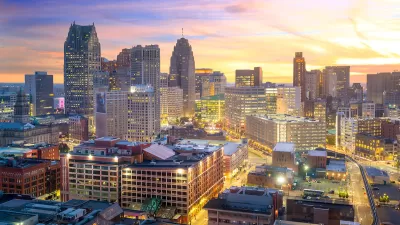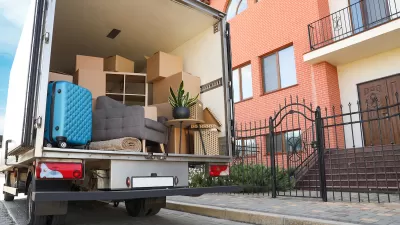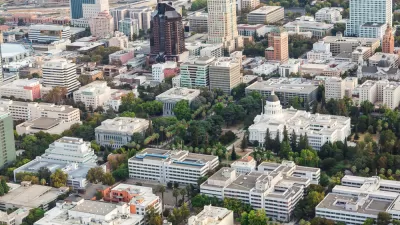As the housing market recovers, are we back to the McMansion-binges of the 2000s? Or, are we growing just a little bit smarter?
A few days ago the LA Times reported that, this October, residential construction permits topped one million for the first time in five years. That fits the narrative of a consistently improving housing market, but I wondered what was behind the numbers: were we back to the McMansion-binges of the 2000s, or were we growing just a little bit smarter?
With multi-family construction permits at a 27-year high (as a share of total residential permits), we're not doing half bad! In 2012, the last full year of data, multi-family residential construction permits accounted for the largest share of total permits issued since 1986. In 2012, 37.5% of new homes were multi-family units, yielding about 1.7 detached homes for every apartment or condo unit. That share reached its nadir in the early 1990s at under 17%—six single-family homes for every multi-family unit!—and held steady at around 25% until 2007:
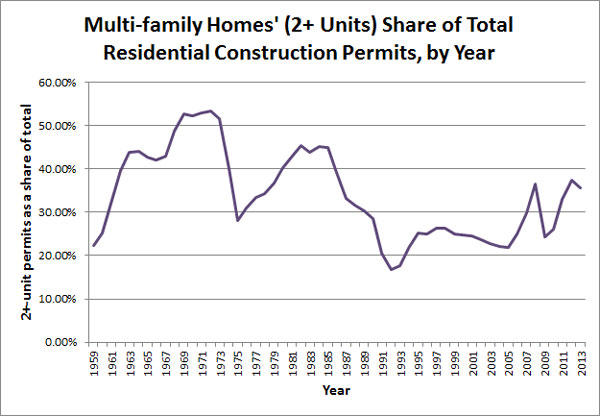
Data from the US Census Bureau [1] [2]
The hope, at this point, is that that little tail emerging in 2013 doesn't continue its descent. If we build too many single-family homes now, a time may come where current owners can't find buyers. As the National Association of Realtors found in their annual report, the sprawling, suburban model probably can't sustain itself if it continues to account for more than 2/3 of overall growth. Even that may be a stretch in the not too distant future.
Here's the data based on the absolute number of building permits issued, rather than ratios (these are divided between single-family and 5+ unit buildings):

Data from the US Census Bureau [1] [2]
As you can see, construction of single-family homes grew consistently—and rather rapidly—from about 1991 to 2005. Over the next four years, it declined nearly 75%; multi-family construction fell nearly as much, though from a much smaller starting point. That peak in multi-family construction in the 1970s is pretty incredible, and I'd be curious to hear the reason behind it, if anyone knows anything about it.
The Census data from the last year also includes regional information:

Data from the US Census Bureau [1] [2]
Here you can see that the Northeast is leading the way in the share of multi-family housing being built, with just about one detached home for every condo or apartment. The South is, not surprisingly, building a lot of single-family homes. Its rapid growth accounts for over half of residential building permits in the country, so it skews the nationwide ratio pretty strongly in that direction.
As a side note, it's interesting to look at how construction of 2-, 3-, and 4-unit construction has changed over the years. Since the late 1950s, these building types accounted for at least 6% of total construction, peaking in the early 1980s at over 10%. Since then they've been on a steady decline, falling to almost 3% in recent years. No love for the lowly duplex these days, even with the uptick in multi-family construction.

Data from the US Census Bureau [1] [2]
And for anyone interested in a graph comparing single-family units to bigger multi-family (5+ unit) buildings, here you go. It accentuates the peaks a bit, but otherwise retains the same general shape as the first graph:
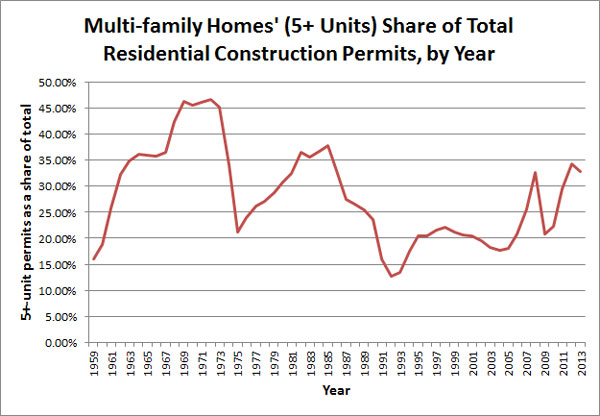

Planetizen Federal Action Tracker
A weekly monitor of how Trump’s orders and actions are impacting planners and planning in America.

Restaurant Patios Were a Pandemic Win — Why Were They so Hard to Keep?
Social distancing requirements and changes in travel patterns prompted cities to pilot new uses for street and sidewalk space. Then it got complicated.

Map: Where Senate Republicans Want to Sell Your Public Lands
For public land advocates, the Senate Republicans’ proposal to sell millions of acres of public land in the West is “the biggest fight of their careers.”

Maui's Vacation Rental Debate Turns Ugly
Verbal attacks, misinformation campaigns and fistfights plague a high-stakes debate to convert thousands of vacation rentals into long-term housing.

San Francisco Suspends Traffic Calming Amidst Record Deaths
Citing “a challenging fiscal landscape,” the city will cease the program on the heels of 42 traffic deaths, including 24 pedestrians.

California Homeless Arrests, Citations Spike After Ruling
An investigation reveals that anti-homeless actions increased up to 500% after Grants Pass v. Johnson — even in cities claiming no policy change.
Urban Design for Planners 1: Software Tools
This six-course series explores essential urban design concepts using open source software and equips planners with the tools they need to participate fully in the urban design process.
Planning for Universal Design
Learn the tools for implementing Universal Design in planning regulations.
Heyer Gruel & Associates PA
JM Goldson LLC
Custer County Colorado
City of Camden Redevelopment Agency
City of Astoria
Transportation Research & Education Center (TREC) at Portland State University
Camden Redevelopment Agency
City of Claremont
Municipality of Princeton (NJ)



























